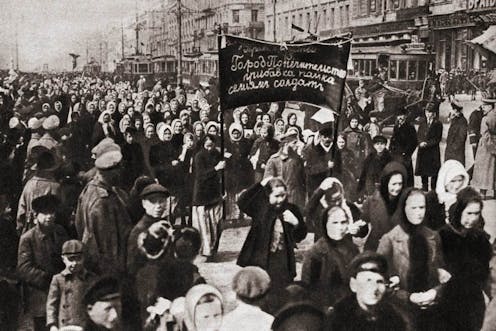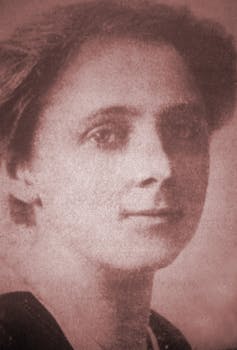One American woman's life in revolutionary Russia
How a journalist from Nebraska chased the 'Soviet dream' all the way to Russia, only to be expelled on accusations of espionage.

Anna Louise Strong, a journalist from Friend, Nebraska, was thrilled by what she heard about the Russian Revolution in 1917.
Although she is almost wholly unknown today, Strong was a household name in her time. She lived in the Soviet Union for 25 years, and made a career of “roving to revolutions, and writing about them for the American press.” She published dozens of books, novels and poetry.
Strong represents a complicated historical figure some might think is better off forgotten. The collapse of the Soviet Union and, more importantly, the violence and repression practiced under Bolshevik rule suggest Strong and other American women who lived and worked there for months or years were wrong to invest their hopes in the revolution.
Yet, revolutionary Russia, at least in theory, offered what many women yearned for – an equal role in public life, equal pay for equal work, access to birth control and abortion, affordable childcare and romantic partnerships based solely on mutual affection. This at a time when American women could not even vote. As I explore in my book, “American Girls in Red Russia,” the the experiences and aspirations of women who, like Strong, placed faith in the “Soviet experiment” beg the question: What does it mean to be on the wrong side of history when you deeply believed you were right?
Called to Russia
“I Change Worlds” is the title of Strong’s 1935 autobiography, but it’s not clear that she changed anything.

Strong learned about the revolution while living in Seattle. She wrote for the Seattle Daily Call, a labor paper that supported the Bolsheviks. Amid growing income inequality, political repression and violent suppression of demands for improved working conditions, radicals hoped for a revolution in the U.S.
To some, talk of the revolution in Russia was thrilling. Strong wrote: “We heard of women’s freedom, of the equality of backward races, of children rationed first when supplies were scant; these things strengthened our enthusiasm.”
Strong has been called a “press agent for some of this century’s least attractive people.” But she never thought of herself as a propagandist. She wanted to tell “a greater story” of what was happening in Russia, using “very simple words,” so that common people in America could relate.
Strong was never a member of the Communist Party. She tried to join, both in the Soviet Union and in the United States, but neither party would have her. Records I examined in the Comintern archives in Moscow point to concerns about her emotional stability; in Moscow Strong was told her application was “premature,” and in the United States she was told she would be more useful outside the party.
On the advice of Lincoln Steffens, a reporter who famously declared upon his return from Soviet Russia, “I have seen the future and it works,” Strong decided to volunteer with the American Friends Service Committee, a Quaker relief organization. Strong asked if she could go to Russia. They said no, and sent her instead to Poland.
In Poland, Strong insisted to her supervisor that she had to cross into Russia when news broke of the 1921 famine, the most extensive and damaging in modern Russian history, affecting some 25 million people. And she actually helped a lot of people. By the time the Quaker office in Philadelphia found out she was there and told her to leave, she’d come down with typhus and almost died. But she wanted to stay where “a world was being born.”
Later, she was given the opportunity to organize an agricultural commune for famine orphans and thereby play a real role in the Soviet enterprise. Strong raised thousands of dollars to support the John Reed colony on the Volga, of which she was nominal “chief.” Strong’s papers at the University of Washington reveal that she eventually figured out that nearly all the money she’d raised was being siphoned off by Russian bureaucrats, who then tried to extort even more money from her. She also started Russia’s first English language newspaper, the Moscow News. Although it was published continuously until shut down by Putin in 2014, it was never the witty, independent paper she’d wanted it to be.
Strong was among the hundreds of “American girls in red Russia.” They were “chic, smart young women” who came “barging into the Red capital, some lending the boys and girls a hand in building Socialism, others seeking husbands among the lonely American engineers, or romantic young Russians, always ready to pay homage to the glamorous American girl,” as one syndicated news article put it in 1932.
Strong did find love in Russia, or so she thought. Leon Trotsky, a Marxist revolutionary and Soviet politician to whom she taught English, was rumored to have been her lover. She married a Russian Communist, which made her feel almost like a real Russian herself. She wrote: “We Russians feel that marriage with us has entered a new stage of development, foreshadowed by some of the friendlier companionships of America, but not widely attainable under capitalism.”
Yet, Strong’s nephew and biographer, whom I interviewed, told me that some people said the party had forced the Russian Communist to marry Strong so that she wouldn’t make any trouble. She was arrested in 1949 in Moscow as a suspected spy and expelled. Back in the United States, she was hounded by the FBI for her Communist ties. Her left-wing former friends shunned her.
Small comfort that Strong was ultimately “rehabilitated” or declared in retrospect not guilty by the Soviets. By that time she’d moved to China, where she lived out the rest of her life, embittered, but still believing in the Soviet dream – if not in Stalin himself. In 1956, after Khrushchev made public the violence enacted under Stalin, Strong admitted that “no man should be deified as Stalin was.”
Lessons for today
If people remember Strong at all today, it is as a Stalinist hack, or the ultimate fellow traveler, a term used for followers of communism who were not members of the Communist Party. The extent of her dedication to the Soviet dream is unusual among the American women who were drawn to the Soviet Union in the 1920s and 1930s. Most of them were more skeptical, or at least more quickly disillusioned.
But what was typical, and what also makes Strong’s story both tragic and still relevant, was the desire that drew her there: desire for a more meaningful life, for a marriage of equals, for worthwhile and fulfilling work, for a more just system that provided health care, maternity leave, equal pay for equal work, child care, legal and free abortions, and access to culture and art.
The Soviet Union, which had no freedom of speech and lacked soap and toilet paper, offered all of these things. Foreigners like Strong somehow found ways to overlook or explain show trials, food lines and gulags.
Julia L. Mickenberg received funding from the National Endowment for the Humanities as well as a number of travel and research grants for the completion of her book, American Girls in Red Russia: Chasing the Soviet Dream (University of Chicago Press, 2017)
Read These Next
As DOJ begins to release Epstein files, his many victims deserve more attention than the powerful me
Powerful men connected to Jeffrey Epstein are named, dissected and speculated about. The survivors,…
How to reduce gift-giving stress with your kids – a child psychologist’s tips for making magic and a
Depending on family circumstances and a child’s personality type, gift giving runs the gamut of fun…
The world risks forgetting one of humanity’s greatest triumphs as polio nears global eradication − 7
Polio may finally be defeated in the next 5 years. Will the world recognize what an extraordinary achievement…





